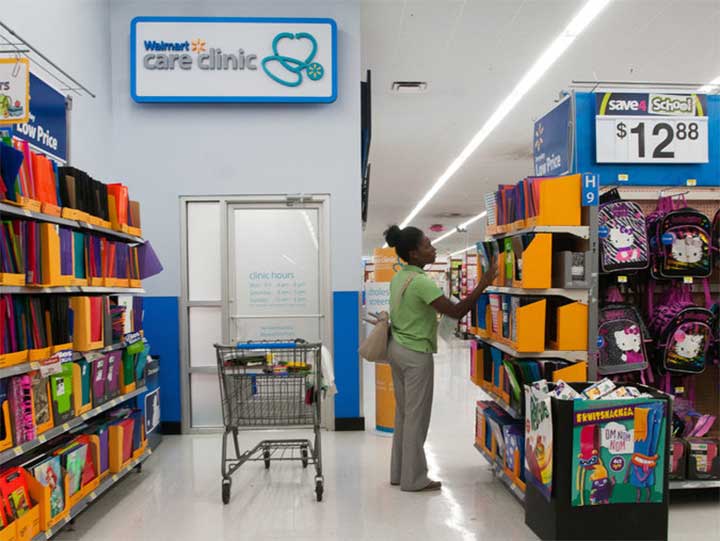Someone who feels ill has two options: He can call his physician’s office and make an appointment—maybe for the same day, maybe not. Then, the patient can drive to the physician’s office and cool his heels for at least 30 minutes beyond the “appointment” time, until he hears his name called. Next comes a quick check of vital signs by a nurse and those words that no patient believes: “The doctor will be right with you.” About 20 minutes later, the physician will appear and examine the patient.
Or he can drive to a retail-based clinic and be examined by a nurse practitioner.
Not surprisingly, more and more patients are choosing the second option. Today, retail-based clinics, also called convenient care clinics, are booming because they offer what people want: convenience, extended hours, and low prices. More than 100 clinics are now open, and at least six chains are building more—a lot more.
MedXpress, a clinic chain that opened in Texas during the summer of 2006, expects to have 500 locations throughout the nation by 2010. Take Care Health, which operates 23 sites in three states, plans to expand to 200 centers by June 2007 and 1,400 centers by 2009.
MinuteClinic, owned by CVS, has 146 clinics operating in 18 states as of mid-January 2007 and will continue to open new clinics throughout the year.
What is a retail-based clinic?
A retail-based clinic is an alternative source for basic healthcare, often positioned in a retail store that has a pharmacy, such as CVS, Rite Aid, Walgreens, and Walmart. Some clinics consist of a single examination room. Others have several examination rooms. All are equipped as outpatient healthcare offices.
These clinics provide care for minor conditions and infections, such as strep throat, bladder infections, sinus infections, pink eye, sprained ankles, rashes, and burns. They also offer screenings, physical examinations, and routine and travel immunizations. Usually, they accept patients older than 18 months.
The clinics aren’t meant to replace the primary care physician. The staff doesn’t treat serious injuries, serious infections, or trauma. Anyone seeking such care at a clinic will be referred to the primary care physician or the emergency department.
Benefits of retail-based clinics
Retail-based clinics offer convenience. They are open 7 days a week and have evening hours. A patient can walk in without an appointment, be seen by a nurse practitioner (or sometimes a physician’s assistant), and be out the door—prescribed drugs in hand—in less than an hour. The on-site pharmacy spares sick people from having to make one more stop before going home.
Typically, the visit is less expensive than a visit to a primary care physician’s office for those who pay cash, and the clinics accept most forms of insurance. The extended hours mean less expense if illness strikes when the physician’s office isn’t open. Instead of going to the emergency department with a minor acute condition, a person can go to the clinic.
Retail-based clinics have written protocols based on national standards and guidelines. Most use electronic health records to facilitate patient flow and continuity of care within other healthcare facilities. And patients usually receive a copy of their health record, which they can share with their primary care provider if they wish. MinuteClinic’s website states that its practitioners follow regularly updated clinical practice guidelines, including those of the American Academy of Pediatrics, the American Medical Association (AMA), and the American Academy of Family Physicians (AAFP). Take Care Health is committed to guidelines set forth by the AMA and AAFP.
Not everyone is happy
Not all groups embrace the clinics. The AAFP and the AMA’s Council on Medical Service (CMS) have issued guidelines emphasizing the clinics’ limited scope of practice and the need for evidence-based medicine, oversight by physicians, referral to physicians when care is outside a clinic’s scope, and electronic medical records.
According to the CMS, some physicians have had to extend their hours and accommodate sick patients who don’t have appointments. Some physicians express concern that the clinics may adversely affect their practices, the coordination of care, and the patient-physician relationship. Other physicians have chosen to partner with the clinics or serve as part of the physician referral network for the clinics.
Want to work at a clinic?
If you’re interested in a career in a retail-based clinic, visit the Convenient Care Association website (www.convenientcareassociation.org) to learn more. The site has a section that lists member organizations that are looking for nurse practitioners and other healthcare professionals.
If you do pursue this career option, be sure to choose an employer carefully. Tracy Klein, a nurse practitioner who worked for a company with retail-based clinics, recommends asking several questions, including whether the company’s scope of practice complies with state and federal laws. Other areas to address include compliance with Occupational Safety and Health Administration regulations, protection of patient privacy, billing practices, malpractice insurance, and organizational structure. Also, make sure you have the equipment you’ll need for the patient population you’ll be seeing.Growth ahead
Nurse practitioner-staffed clinics offer basic healthcare that’s fast, convenient, and inexpensive. For these and other reasons, the growth of retail-based clinics is just beginning. In this era of long waits in physician offices, retail-based clinics are just what the patient—and the nurse practitioner—ordered.
Selected references
American Academy of Family Physicians Policy and Advocacy. Desired attributes of retail clinics.” Available at: http://www.aafp.org/online/en/home/policy/policies/r/retailhealthclinics.html. Accessed January 23, 2007.
American Medical Association. Report 7 of the Council on Medical Service. Available at: http://www.ama-assn.org/ama1/pub/upload/mm/372/a-06cmsreport7.pdf. Accessed January 23, 2007.
Barrett J. “Want treatment with those pills?” MSNBC Newsweek Health. Available at: http://msnbc.msn.com/id/14014782/site/newsweek. Accessed January 23, 2007.
Hansen-Turton T, Ryan S, Miller K, Counts M, Nash DB. Convenient care clinics: the future of accessible health care. Available at: http://www.convenientcareassociation.org/WhitePaperforDistribution.pdf. Accessed January 23, 2007.
Kline TA. Working in a retail clinic: what nurse practitioners need to ask. Topics in Advanced Practice Nursing eJournal. Available at: http://www.medscape.com/viewarticle/544422_1. Accessed January 23, 2007.
For a complete list of selected references, see March 2007 references.


















